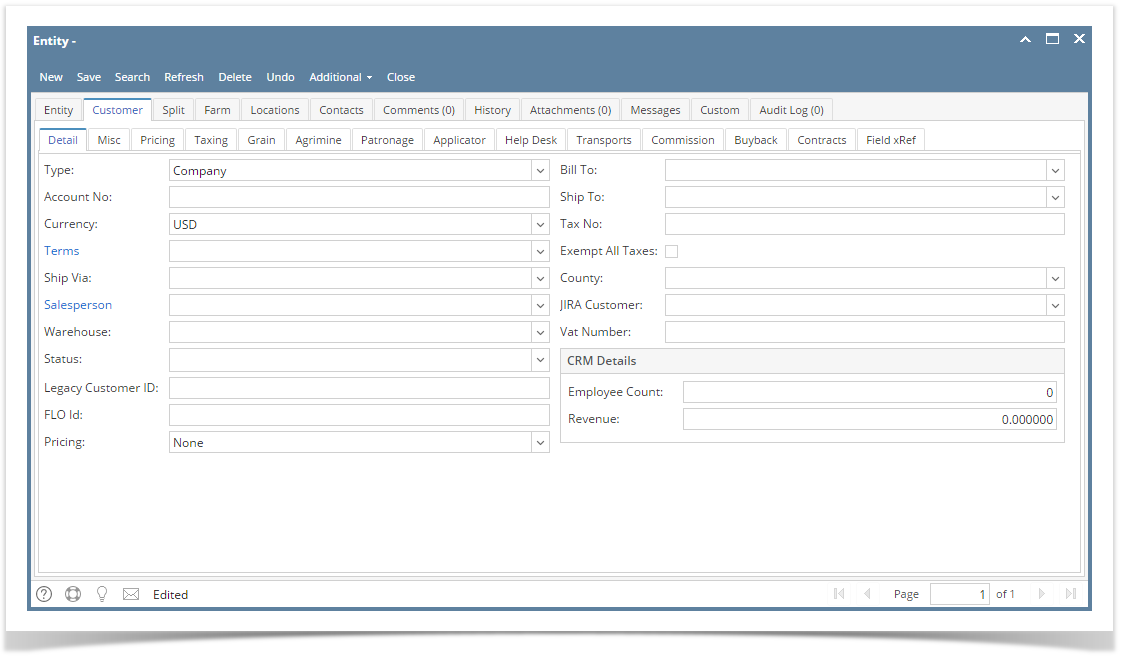Page History
The Customer Entity screen is used to maintain all the detailed information about the customer. This is the master record of the customer. Open the screen from Sales | Customers menu.
Field Description
| Expand | ||
|---|---|---|
| ||
Type - Select the appropriate customer type from the combo box list. The combo box selections are Company and Person. Account No - Enter the customer's account number. Currency - Select from the combo box list the default currency that will be used by the customer. The combo box list will retrieve the record from the Currency screen.Credit Limit - Enter the credit limit amount available to this customer. Terms - Click the combo box button, then select the appropriate Terms for the location. The combo box list will retrieve the active terms record from the Terms screen. Ship Via - Click the combo box button, then select the appropriate Ship Via for the location. The combo box list will retrieve the records from the Ship Via screen. AR Balance - This is a disabled and computed field showing the customer's outstanding balance. Salesperson - Select the salesperson Id associated to the customer. The combo box list will show all the active salesperson on the system. Warehouse - This is the customer's default warehouse. This field will get its data from the primary Location, but you can change the value of this field if necessary. Status - Select the appropriate account status of the customer. The combo box list will show all the records on Account Status Code. This field will allow you to assign multiple status codes to a customer. Legacy Customer ID - This is a read-only field which will show the origin customer number of the imported customer. If the customer is created in i21, this field will show the same value in Entity No field. FLO Id - Pricing - The default value is set to None. Select the specific pricing discount for the customer. The combo box selections are Discount Sales Price, Markup Standard Cost, Percent of Margin, Multi-Level Pricing, Retail Price, Last Price, Inventory Price List, and None. Bill To - This will default to the value in Location Name field when adding a customer. For an existing customer record, you can assign a different Bill To by selecting on the combo box list. The combo box list will show the locations added on the Locations tab. Ship To - This will default to the value in Location Name field when adding a customer. For an existing customer you can select the appropriate location where purchases of the customer will be shipped. The combo box list will show the location added on the Locations tab. Tax No - Enter the customer's tax number. Tax Exempt All Taxes - Check this check box if the customer will be exempted from tax charges on any transaction. County - Select the Country where the customer belongs to. The combo box list will show the County used in Tax Codes. Print 1099 - This will state if a 1099 is required or not. This will determine the type of 1099 information to be tracked. The selections are Yes and No. 1099 Name - Enter the name that will appear in the 1099 form. 1099 Form - Select from the predefined list of 1099 forms. 1099 Type - Select from the predefined list of 1099 types. Federal Tax ID - Enter the customer's federal identification. W9 Signed - Enter the date this customer signed a W9 form. JIRA Customer - Select the corresponding customer name on JIRA. Vat Number - Employee Count - Revenue - |
| Expand | ||
|---|---|---|
| ||
Credit Limit - Enter the credit limit amount available to this customer. AR Balance - This is a disabled and computed field showing the customer's outstanding balanceJIRA Customer - Select the corresponding customer name on JIRA. Active - Check the button to activate a customer. Otherwise, deselect it. Inactive Customers are not selectable on customer related combo box lists. Refer also to How to Activate/Deactivate a Customer Prospect - Check this combo box if the current record is still a prospect. PO Required - Check this option if a purchase order number is required to be entered in the invoice. Otherwise, deselect the button. Credit Hold - You may put the customer on credit hold by checking this option. Budget Begin Date - Enter the starting date of the new budget schedule to be generated. You can click on the mini-calendar button and select the date, or manually type the date. Monthly Budget - Enter the default monthly amount of budget. No of Periods - Enter the number of periods the budget will be generated. Service Charge - Select the appropriate service charge code that will be used when computing the customer's service charges. **Note: Business process of other fields are not yet implemented. |
Pages
| Children Display | ||||
|---|---|---|---|---|
|
...

